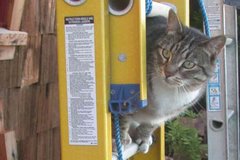Box Cores and Stress Relief!
The official CASEIS Cruise Blog is located here: http://www.ipgp.fr/caseis This official blog is written by my shift-mate Lola Johannes.
Box Cores, mud pies, and BBQ.
- Here is a site map for the cores that we have collected so far. This is similar to maps that I have previously posted. The dots in blue show the locations of our actual core sites. We recently collected a 20.02 m piston core CAS16-21PC in an isolated basin east of the main slope, a basin formed by a backthrust fault in the western accretionary prism. We also collected a box core (CAS16-22BC) in this same location. Based upon correlations between PCs and BCs, it is good that we are collecting these BCs as there is from 0-30 cm missing sediment at the tops of our PCs. Also, BCs are better for sampling for 210Pb since the uppermost sediment in PCs, even if it is completely there, is disturbed when we curate the cores on the deck.
June 14, 2016
- Here Chloe anxiously awaits the arrival of 22BC. The ship’s engineers are getting ready to bring it on board.
- Here the engineers carefully lower the BC onto the deck.
- Here the engineers unbolt the part of the corer that contains the sediment from the part of the corer that has the rest of the mechanisms for coring. This is similar to the piston corer, where there is the core barrel and the rest of the mechanisms.
- Next we drain the water from the top of the core by drinking the sea water. Not really, we just use this tubing to siphon the water. Quentin D. is on the left and Charles Deschamps, from another shift, helps us do this because this is our first BC and he has done this for 4 BCs.
- We remove some sediment stuck to the outside of the BC, captured by the trap door used to keep the sediment in the core. Dr. Beck shows us that there are abundant forams in this sediment. Look for the small white grains exposed in the sediment. Those are the forams. Whomever gets to pick the forams for radiocarbon age control will be lucky since they are so large (this requires fewer numbers of forams than in an oceanographic setting that has smaller sized forams, like the northeast Pacific).
- Then we measure the thickness of the sediment so that we can cut the sub-sampling cores to the correct length.
- Here Quentin holds the sub-sampling core as Dr. Beck cuts it with his meat cutting saw.
- Here Chloe, Gaelle, Lola, and Marie show us that they have cleaned and labeled the cores. We will take 3 sub-samples.
- Here Chloe inserts the core into the sediment.
- Here Quentin D. measures the sediment inside and outside of the core to determine how much compaction might have occurred inside of the core.
- We can see that there are abundant forams on the surface of the sediment, along with some small pieces of shell (the larger white pieces).
- Next we remove some bolts to allow us to lift up the side of the BC. This reveals the sediment stratigraphy. The sediment in this core does not appear to have any sandy turbidites in the surface. There may be muddy turbidites, but we will need to wait until we can CT scan the sub-sample cores.
- Then we dig out the sediment surrounding the sub-sample cores so that we can place caps on them.
- This process allows for a well-deserved stress reliever, the mud fight. People got to paint each other with mud and this was lots of fun. Here is Marie modeling her mud markings.
- Here my shift mates continue to play with the mud as they clean out the BC. There is nothing better than a mud fight as it helps people to remember to have fun. I watch from the sidelines to ensure that I can prevent mud from getting into my camera. Heheh.
- This is the sunset from the end of this day.
- Dr. Feuillet and the second chief mate Martin work closely together to navigate around a small target area in the subduction zone trench. We found some promising CHIRP seismic data but the trench is filled with hummocky topography and the target sedimentary layers are in small regions between the hummocks.
- This is a panorama from the bridge.
- Patrice Woerther gave a presentation today about how he and his colleagues have designed the coring system used on the ship. This system uses pressure transducers and accelerometers to evaluate how the piston coring system performs while coring. These data allow them to configure the coring system to collect sediment in the core that is not deformed.






















No comments:
Post a Comment